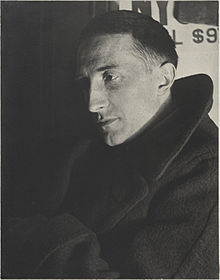
Back Marcel Duchamp Afrikaans Marcel Duchamp ALS مارسيل دوشامب Arabic مارسيل دوشامب ARZ Marcel Duchamp AST Marsel Düşan Azerbaijani Марсель Дюшан Bashkir Марсель Дзюшан Byelorussian Марсел Дюшан Bulgarian Marcel Duchamp Breton
Marcel Duchamp | |
|---|---|
 Portrait of Marcel Duchamp, 1920–21 by Man Ray, Yale University Art Gallery | |
| Born | Henri-Robert-Marcel Duchamp 28 July 1887 Blainville-Crevon, France |
| Died | 2 October 1968 (aged 81) Neuilly-sur-Seine, France |
| Known for | Painting, sculpture, film |
| Notable work | Nude Descending a Staircase, No. 2 (1912) Fountain (1917) The Bride Stripped Bare By Her Bachelors, Even (1915–1923) LHOOQ (1919) Étant donnés (1946–1966) |
| Movement | Cubism, Dada, conceptual art |
| Spouses | |
| Partner(s) | Mary Reynolds (1929–1946) Maria Martins (1946–1951) |
Henri-Robert-Marcel Duchamp (UK: /ˈdjuːʃɒ̃/, US: /djuːˈʃɒ̃, djuːˈʃɑːmp/;[1] French: [maʁsɛl dyʃɑ̃]; 28 July 1887 – 2 October 1968) was a French painter, sculptor, chess player, and writer whose work is associated with Cubism, Dada, and conceptual art.[2][3][4] He is commonly regarded, along with Pablo Picasso and Henri Matisse, as one of the three artists who helped to define the revolutionary developments in the plastic arts in the opening decades of the 20th century, responsible for significant developments in painting and sculpture.[5][6][7][8] He has had an immense impact on 20th- and 21st-century art, and a seminal influence on the development of conceptual art. By the time of World War I, he had rejected the work of many of his fellow artists (such as Henri Matisse) as "retinal", intended only to please the eye. Instead, he wanted to use art to serve the mind.[9]
- ^ Jones, Daniel (2011). Roach, Peter; Setter, Jane; Esling, John (eds.). "Duchamp". Cambridge English Pronouncing Dictionary (18th ed.). Cambridge University Press. p. 151. ISBN 978-0-521-15255-6.
- ^ Ian Chilvers & John Glaves-Smith, A Dictionary of Modern and Contemporary Art. Oxford University Press, p. 203
- ^ "Francis M. Naumann, Marcel Duchamp, Grove Art Online, Oxford University Press, MoMA, 2009". Moma.org. Retrieved 11 May 2014.
- ^ "Marcel Duchamp". TheArtStory.org. Archived from the original on 27 June 2013. Retrieved 8 May 2013.
- ^ "Tate Modern: Matisse Picasso". Tate Etc. Archived from the original on 18 April 2014. Retrieved 13 February 2010.
- ^ Searle, Adrian (7 May 2002). "A momentous, tremendous exhibition". The Guardian. London. Archived from the original on 2 October 2013. Retrieved 13 February 2010.
- ^ Trachtman, Paul (February 2003). "Matisse & Picasso". Smithsonian. Archived from the original on 8 May 2010. Retrieved 13 February 2010.
- ^ "Duchamp's urinal tops art survey". BBC News. 1 December 2004. Archived from the original on 27 November 2010. Retrieved 10 December 2010.
- ^ "Marcel Duchamp (1887-1968) | Thematic Essay | Heilbrunn Timeline of Art History | the Metropolitan Museum of Art". Archived from the original on 30 September 2013. Retrieved 27 September 2013. Marcel Duchamp (1887–1968) at Metropolitan Museum of Art